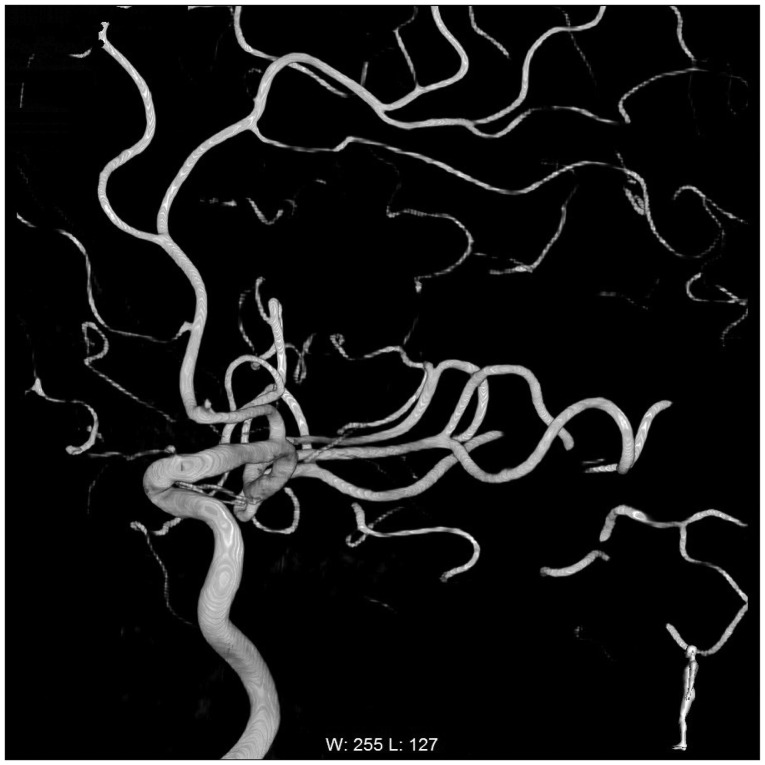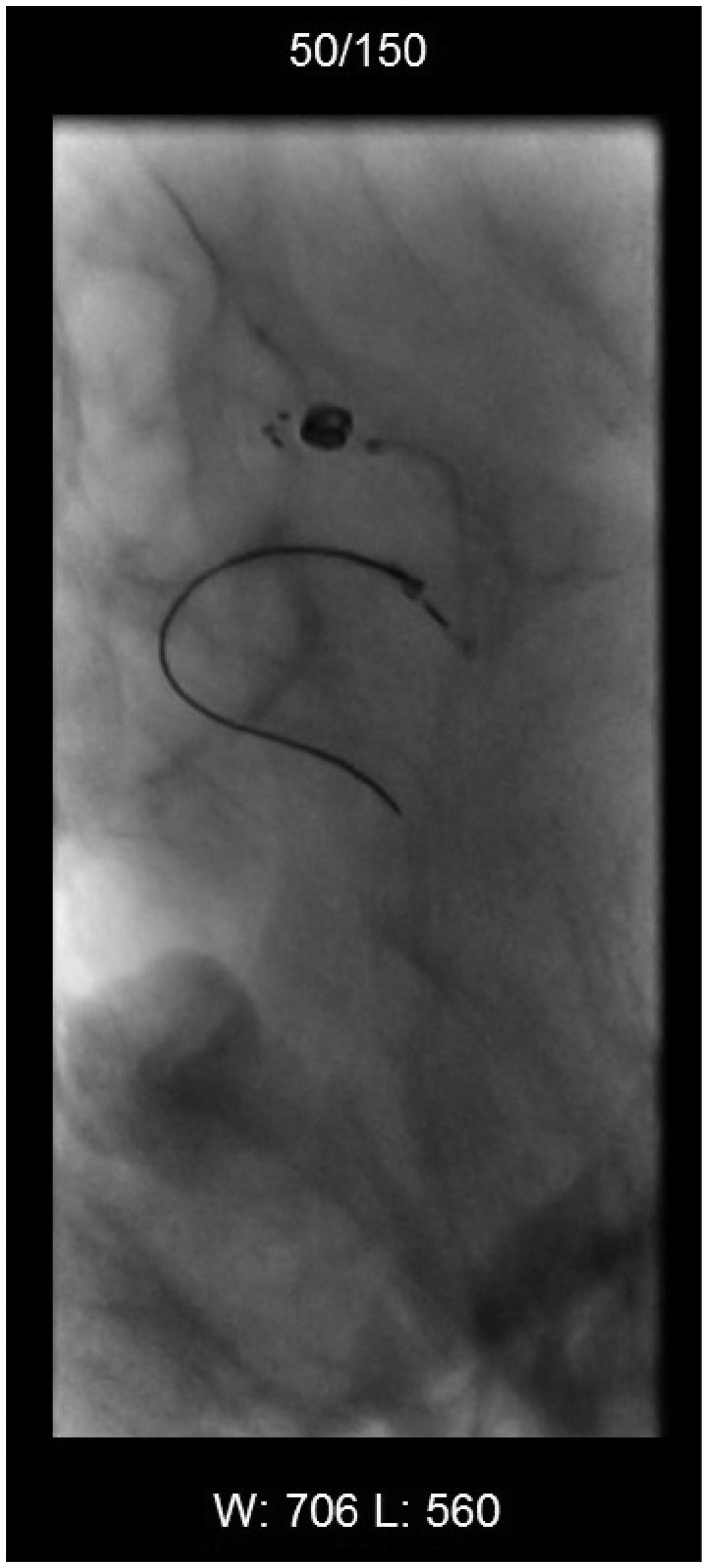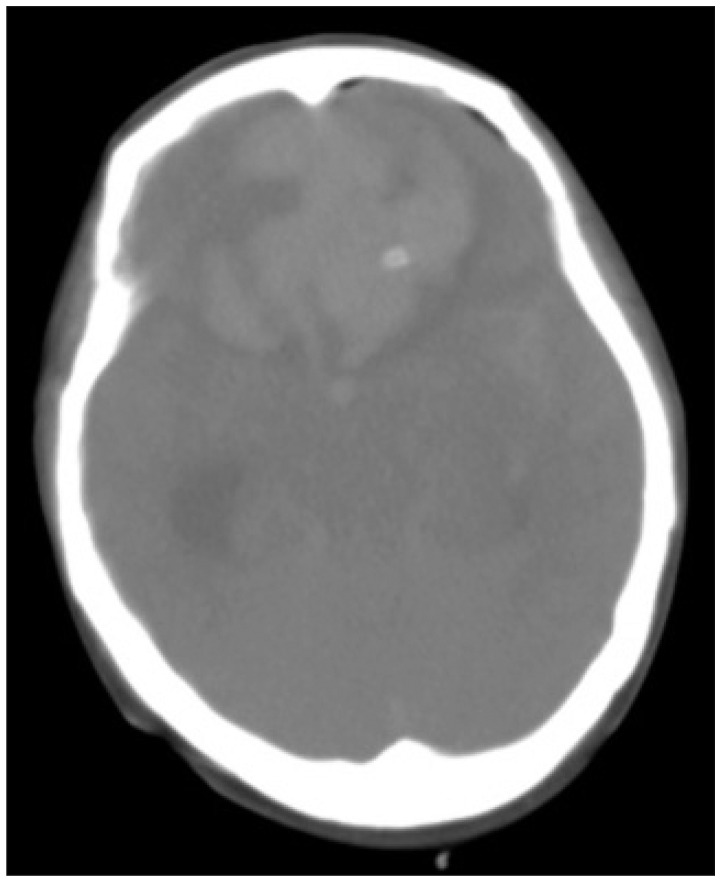J Korean Neurosurg Soc.
2016 Jul;59(4):341-345. 10.3340/jkns.2016.59.4.341.
Solitaire AB Stent-Assisted Coiling of Wide-Neck Micro Aneurysms
- Affiliations
-
- 1Department of Neurosurgery, Liuzhou Workers' Hospital, Guangxi, PR China. CJKDOCTORLGY@163.com
- KMID: 2315967
- DOI: http://doi.org/10.3340/jkns.2016.59.4.341
Abstract
OBJECTIVE
Solitaire AB stent-assisted coiling facilitates the endovascular treatment of wide-necked intracranial aneurysms. We present our experience of coiling the micro-aneurysms of wide-neck with Solitaire AB stent assisting in a single center.
METHODS
Thirty-one Solitaire AB stents were used to treat via endovascular approach patients with 31 wide-neck micro aneurysms in a single center in China. Technical and clinical complications were recorded. Modified Rankin Scale was used to evaluate the patients' conditions via clinic and telephone follow-up.
RESULTS
The mean width of aneurysm sac was 2.30±0.42 mm, and the mean diameter of aneurysm neck was 2.83±0.48 mm. Complete occlusion was achieved in 28 aneurysms (90.32%); neck remnant was seen in 3 aneurysms (9.68%). Technical and clinical complications related to the procedure were encountered in four patients (12.5%). Two patients died (6.25%). No patient had a permanent deficit.
CONCLUSION
Solitaire AB stent was a safe and efficiency tool in assisting coiling of micro aneurysms with wide neck, but may be not suitable for a blaster-like one. Mid- and long-term follow-up will be required to elucidate the impact of the Solitaire AB stent on recanalization rate.
Keyword
Figure
Reference
-
1. Ahn JY, Cho JH, Jung JY, Lee BH, Yoon PH. Blister-like aneurysms of the supraclinoid internal carotid artery : challenging endovascular treatment with stent-assisted coiling. J Clin Neurosci. 2008; 15:1058–1061. PMID: 18644728.
Article2. Biondi A, Janardhan V, Katz JM, Salvaggio K, Riina HA, Gobin YP. Neuroform stent-assisted coil embolization of wide-neck intracranial aneurysms : strategies in stent deployment and midterm follow-up. Neurosurgery. 2007; 61:460–468. discussion 468-469. PMID: 17881956.3. Clajus C, Sychra V, Strasilla C, Klisch J. Stent-assisted coil embolization of intracranial aneurysms using the Solitaire™ AB Neurovascular Remodeling Device : initial and midterm follow-up results. Neuroradiology. 2013; 55:629–638. PMID: 23386222.
Article4. Gory B, Klisch J, Bonafé A, Mounayer C, Beaujeux R, Moret J, et al. Solitaire AB stent-assisted coiling of wide-necked intracranial aneurysms : mid-term results from the SOLARE Study. Neurosurgery. 2014; 75:215–219. discussion 219. PMID: 24818784.
Article5. Gory B, Klisch J, Bonafé A, Mounayer C, Beaujeux R, Moret J, et al. Solitaire AB stent-assisted coiling of wide-necked intracranial aneurysms : short-term results from a prospective, consecutive, European multicentric study. Neuroradiology. 2013; 55:1373–1378. PMID: 24057085.
Article6. Gupta V, Chugh M, Jha AN, Walia BS, Vaishya S. Coil embolization of very small (2 mm or smaller) berry aneurysms : feasibility and technical issues. AJNR Am J Neuroradiol. 2009; 30:308–314. PMID: 19001535.
Article7. Henkes H, Flesser A, Brew S, Miloslavski E, Doerfler A, Felber S, et al. A novel microcatheter-delivered, highly-flexible and fully-retrievable stent, specifically designed for intracranial use. Technical note. Interv Neuroradiol. 2003; 9:391–393. PMID: 20591320.
Article8. Ishikawa T, Mutoh T, Nakayama N, Yasuda H, Nomura M, Kazumata K, et al. Universal external carotid artery to proximal middle cerebral artery bypass with interposed radial artery graft prior to approaching ruptured blood blister-like aneurysm of the internal carotid artery. Neurol Med Chir (Tokyo). 2009; 49:553–558. PMID: 19940410.
Article9. Kamijo K, Matsui T. Acute extracranial-intracranial bypass using a radial artery graft along with trapping of a ruptured blood blister-like aneurysm of the internal carotid artery. Clinical article. J Neurosurg. 2010; 113:781–785. PMID: 19929189.
Article10. Kawashima A, Okada Y, Kawamata T, Onda H, Kubo O, Hori T. Successful treatment of a blood blister-like aneurysm of the internal carotid artery by trapping with a high-flow bypass. J Clin Neurosci. 2008; 15:797–800. PMID: 18406147.
Article11. Kim BM, Chung EC, Park SI, Choi CS, Won YS. Treatment of blood blister-like aneurysm of the internal carotid artery with stent-assisted coil embolization followed by stent-within-a-stent technique. Case report. J Neurosurg. 2007; 107:1211–1213. PMID: 18077959.
Article12. Klisch J, Eger C, Sychra V, Strasilla C, Basche S, Weber J. Stent-assisted coil embolization of posterior circulation aneurysms using solitaire ab : preliminary experience. Neurosurgery. 2009; 65:258–266. discussion 266. PMID: 19625903.
Article13. Korja M, Rautio R, Valtonen S, Haapanen A. Primary treatment of ruptured blood blister-like aneurysms with stent-assisted coil embolization : report of two cases. Acta Radiol. 2008; 49:180–183. PMID: 18300143.
Article14. Krischek O, Miloslavski E, Fischer S, Shrivastava S, Henkes H. A comparison of functional and physical properties of self-expanding intracranial stents [Neuroform3, Wingspan, Solitaire, Leo+, Enterprise]. Minim Invasive Neurosurg. 2011; 54:21–28. PMID: 21506064.
Article15. Lee JW, Choi HG, Jung JY, Huh SK, Lee KC. Surgical strategies for ruptured blister-like aneurysms arising from the internal carotid artery : a clinical analysis of 18 consecutive patients. Acta Neurochir (Wien). 2009; 151:125–130. PMID: 19194654.
Article16. McNeely PD, Clarke DB, Baxter B, Vandorpe RA, Mendez I. Endovascular treatment of a "blister-like" aneurysm of the internal carotid artery. Can J Neurol Sci. 2000; 27:247–250. PMID: 10975539.
Article17. Mocco J, Snyder KV, Albuquerque FC, Bendok BR, Alan SB, Carpenter JS, et al. Treatment of intracranial aneurysms with the Enterprise stent : a multicenter registry. J Neurosurg. 2009; 110:35–39. PMID: 18976057.
Article18. Molyneux A, Kerr R, Stratton I, Sandercock P, Clarke M, Shrimpton J, et al. International Subarachnoid Aneurysm Trial (ISAT) of neurosurgical clipping versus endovascular coiling in 2143 patients with ruptured intracranial aneurysms : a randomised trial. Lancet. 2002; 360:1267–1274. PMID: 12414200.
Article19. Park JH, Park IS, Han DH, Kim SH, Oh CW, Kim JE, et al. Endovascular treatment of blood blister-like aneurysms of the internal carotid artery. J Neurosurg. 2007; 106:812–819. PMID: 17542524.
Article20. Pierot L, Spelle L, Vitry F. ATENA Investigators. Immediate clinical outcome of patients harboring unruptured intracranial aneurysms treated by endovascular approach : results of the ATENA study. Stroke. 2008; 39:2497–2504. PMID: 18617659.
Article21. Piotin M, Blanc R, Spelle L, Mounayer C, Piantino R, Schmidt PJ, et al. Stent-assisted coiling of intracranial aneurysms : clinical and angiographic results in 216 consecutive aneurysms. Stroke. 2010; 41:110–115. PMID: 19959540.22. Regelsberger J, Matschke J, Grzyska U, Ries T, Fiehler J, Köppen J, et al. Blister-like aneurysms--a diagnostic and therapeutic challenge. Neurosurg Rev. 2011; 34:409–416. PMID: 21584689.
Article23. Shapiro M, Becske T, Sahlein D, Babb J, Nelson PK. Stent-supported aneurysm coiling : a literature survey of treatment and follow-up. AJNR Am J Neuroradiol. 2012; 33:159–163. PMID: 22033717.
Article24. Shimizu H, Matsumoto Y, Tominaga T. Non-saccular aneurysms of the supraclinoid internal carotid artery trunk causing subarachnoid hemorrhage : acute surgical treatments and review of literatures. Neurosurg Rev. 2010; 33:205–216. PMID: 20521339.
Article
- Full Text Links
- Actions
-
Cited
- CITED
-
- Close
- Share
- Similar articles
-
- Waffle-Cone Technique Using Solitaire AB Stent
- Outcomes of Stent-assisted Coil Embolization of Wide-necked Intracranial Aneurysms Using the Solitaire(TM) AB Neurovascular Remodeling Device
- Clinical and Angiographic Outcomes of Wide-necked Aneurysms Treated with the Solitaire AB Stent
- Clinical and Angiographic Outcomes of Aneurysms Treated with Two Self-expanding Stent-assisted Coiling Systems: A Comparison of Solitaire AB and Enterprise VRD Stents
- Very Late Stent Thrombosis after Sole Stent-Assisted Coiling at the Paraclinoid Giant Aneurysm : Could Prophylactic Antiplatelet Therapy Be Ceased at the Only 1 Year after Procedure?





